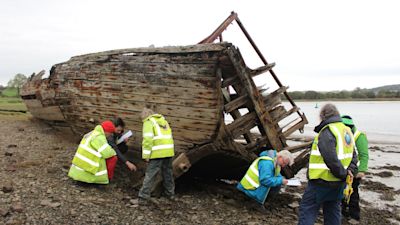Why archaeologists are studying Kirkcudbright's shipwrecks

Article and video report by Sandy McCracken.
When we think of archaeology we usually think of old ruins and trenches in fields, but in Kirkcudbright they have been looking out to sea - examining shipwrecks to learn valuable information about our social history.
The town sits where the River Dee meets the Solway Firth, and has provided a safe harbour for many centuries. Last year a project examined the remains of beached vessels that sit on the shoreline of the bay.
The unusual dig was a collaboration between the Galloway Glens’ Can you Dig it Scheme, the Solway Firth Partnership and coastal history specialists SCAPE.
Helen Keron, the Galloway Glens Education & Community Engagement Officer said: “I think they have a lot of interest in it because of the insight it gives to our maritime and coastal history. It’s a fascinating aspect of archaeology that sometimes gets overlooked.
"What’s very interesting about it is that it’s always changing, so it’s terribly important that we get out and record it now for future generations.”
For SCAPE archaeologist Elinor Graham the decaying vessels presented a fleeting opportunity to learn about the history of the Solway coast
She said: “Kirkcudbright bay has a long and rich history of maritime trade and fishing so we were aware of some of the amazing sights around there.
"This particular Boat – The Fauna – it’s had a particularly long life so you can not only learn about the boat itself and how it’s been used but how society changed.
"These really are rich archives of information about Scotland’s heritage about our history going back tens of years, hundreds of years and even thousands of years.
"It is under threat by things such as climate change, erosion and sea level rise, all of which are eating away and stealing our history, washing it away quite literally so there is a real urgency to look at these sites and learn what we can before they are lost forever.”
The findings of the project will be presented at a public online event on Wednesday, 12 August and organisers are keen to hear from anybody who has their own story to tell about these wrecks to help build a permanent record of these fast vanishing artefacts.
Details can be found here.